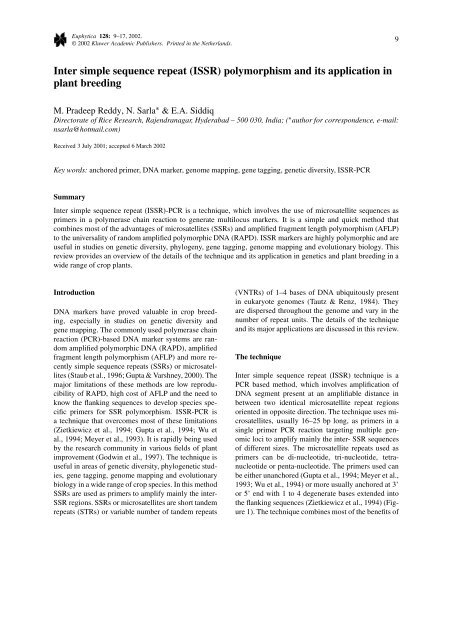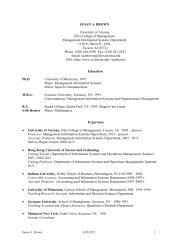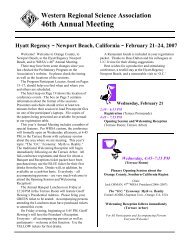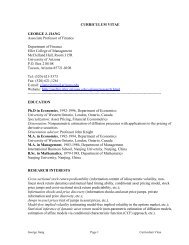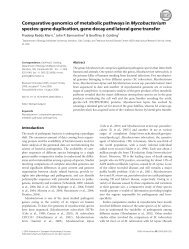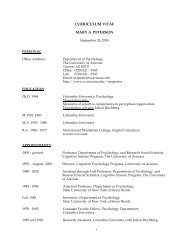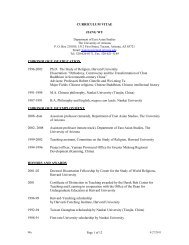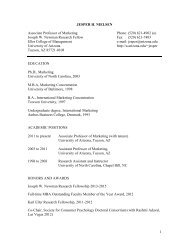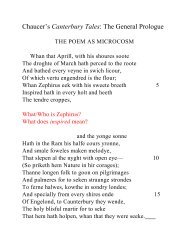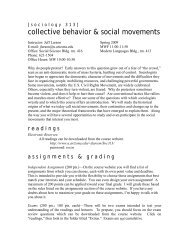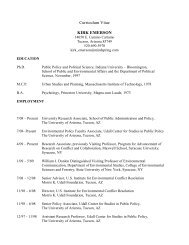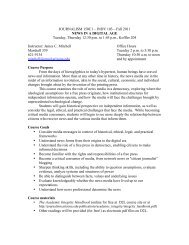Inter simple sequence repeat (ISSR) polymorphism and its ...
Inter simple sequence repeat (ISSR) polymorphism and its ...
Inter simple sequence repeat (ISSR) polymorphism and its ...
Create successful ePaper yourself
Turn your PDF publications into a flip-book with our unique Google optimized e-Paper software.
Euphytica 128: 9–17, 2002.<br />
© 2002 Kluwer Academic Publishers. Printed in the Netherl<strong>and</strong>s.<br />
9<br />
<strong>Inter</strong> <strong>simple</strong> <strong>sequence</strong> <strong>repeat</strong> (<strong>ISSR</strong>) <strong>polymorphism</strong> <strong>and</strong> <strong>its</strong> application in<br />
plant breeding<br />
M. Pradeep Reddy, N. Sarla ∗ & E.A. Siddiq<br />
Directorate of Rice Research, Rajendranagar, Hyderabad – 500 030, India; ( ∗ author for correspondence, e-mail:<br />
nsarla@hotmail.com)<br />
Received 3 July 2001; accepted 6 March 2002<br />
Key words: anchored primer, DNA marker, genome mapping, gene tagging, genetic diversity, <strong>ISSR</strong>-PCR<br />
Summary<br />
<strong>Inter</strong> <strong>simple</strong> <strong>sequence</strong> <strong>repeat</strong> (<strong>ISSR</strong>)-PCR is a technique, which involves the use of microsatellite <strong>sequence</strong>s as<br />
primers in a polymerase chain reaction to generate multilocus markers. It is a <strong>simple</strong> <strong>and</strong> quick method that<br />
combines most of the advantages of microsatellites (SSRs) <strong>and</strong> amplified fragment length <strong>polymorphism</strong> (AFLP)<br />
to the universality of r<strong>and</strong>om amplified polymorphic DNA (RAPD). <strong>ISSR</strong> markers are highly polymorphic <strong>and</strong> are<br />
useful in studies on genetic diversity, phylogeny, gene tagging, genome mapping <strong>and</strong> evolutionary biology. This<br />
review provides an overview of the details of the technique <strong>and</strong> <strong>its</strong> application in genetics <strong>and</strong> plant breeding in a<br />
wide range of crop plants.<br />
Introduction<br />
DNA markers have proved valuable in crop breeding,<br />
especially in studies on genetic diversity <strong>and</strong><br />
gene mapping. The commonly used polymerase chain<br />
reaction (PCR)-based DNA marker systems are r<strong>and</strong>om<br />
amplified polymorphic DNA (RAPD), amplified<br />
fragment length <strong>polymorphism</strong> (AFLP) <strong>and</strong> more recently<br />
<strong>simple</strong> <strong>sequence</strong> <strong>repeat</strong>s (SSRs) or microsatellites<br />
(Staub et al., 1996; Gupta & Varshney, 2000). The<br />
major limitations of these methods are low reproducibility<br />
of RAPD, high cost of AFLP <strong>and</strong> the need to<br />
know the flanking <strong>sequence</strong>s to develop species specific<br />
primers for SSR <strong>polymorphism</strong>. <strong>ISSR</strong>-PCR is<br />
a technique that overcomes most of these limitations<br />
(Zietkiewicz et al., 1994; Gupta et al., 1994; Wu et<br />
al., 1994; Meyer et al., 1993). It is rapidly being used<br />
by the research community in various fields of plant<br />
improvement (Godwin et al., 1997). The technique is<br />
useful in areas of genetic diversity, phylogenetic studies,<br />
gene tagging, genome mapping <strong>and</strong> evolutionary<br />
biology in a wide range of crop species. In this method<br />
SSRs are used as primers to amplify mainly the inter-<br />
SSR regions. SSRs or microsatellites are short t<strong>and</strong>em<br />
<strong>repeat</strong>s (STRs) or variable number of t<strong>and</strong>em <strong>repeat</strong>s<br />
(VNTRs) of 1–4 bases of DNA ubiquitously present<br />
in eukaryote genomes (Tautz & Renz, 1984). They<br />
are dispersed throughout the genome <strong>and</strong> vary in the<br />
number of <strong>repeat</strong> un<strong>its</strong>. The details of the technique<br />
<strong>and</strong> <strong>its</strong> major applications are discussed in this review.<br />
The technique<br />
<strong>Inter</strong> <strong>simple</strong> <strong>sequence</strong> <strong>repeat</strong> (<strong>ISSR</strong>) technique is a<br />
PCR based method, which involves amplification of<br />
DNA segment present at an amplifiable distance in<br />
between two identical microsatellite <strong>repeat</strong> regions<br />
oriented in opposite direction. The technique uses microsatellites,<br />
usually 16–25 bp long, as primers in a<br />
single primer PCR reaction targeting multiple genomic<br />
loci to amplify mainly the inter- SSR <strong>sequence</strong>s<br />
of different sizes. The microsatellite <strong>repeat</strong>s used as<br />
primers can be di-nucleotide, tri-nucleotide, tetranucleotide<br />
or penta-nucleotide. The primers used can<br />
be either unanchored (Gupta et al., 1994; Meyer et al.,<br />
1993; Wu et al., 1994) or more usually anchored at 3’<br />
or 5’ end with 1 to 4 degenerate bases extended into<br />
the flanking <strong>sequence</strong>s (Zietkiewicz et al., 1994) (Figure<br />
1). The technique combines most of the benef<strong>its</strong> of
10<br />
Figure 1. <strong>ISSR</strong>-PCR: A schematic representation of a single primer (AG) 8 , unanchored (a), 3’-anchored (b) <strong>and</strong> 5’-anchored (c) targeting a<br />
(TC) n <strong>repeat</strong> used to amplify inter <strong>simple</strong> <strong>sequence</strong> <strong>repeat</strong> region flanked by two inversely oriented (TC) n <strong>sequence</strong>s. (a) Unanchored (AG) n<br />
primer can anneal anywhere in the (TC) n <strong>repeat</strong> region on the template DNA leading to slippage <strong>and</strong> ultimately smear formation (b) (AG) n<br />
primer anchored with 2 nucleotides (NN) at the 3’ end anneals at specific regions on the template DNA <strong>and</strong> produces clear b<strong>and</strong>s (c) (AG) n<br />
primer anchored with 2 nucleotides (NN) at the 5’ end anneals at specific regions <strong>and</strong> amplifies part of the <strong>repeat</strong> region also leading to larger<br />
b<strong>and</strong>s.
11<br />
AFLP <strong>and</strong> microsatellite analysis with the universality<br />
of RAPD. <strong>ISSR</strong>s have high reproducibility possibly<br />
due to the use of longer primers (16–25 mers) as compared<br />
to RAPD primers (10- mers) which perm<strong>its</strong> the<br />
subsequent use of high annealing temperature (45–<br />
60 ◦ C) leading to higher stringency. The studies on<br />
reproducibility show that it is only the faintest b<strong>and</strong>s<br />
that are not reproducible. About 92–95% of the scored<br />
fragments could be <strong>repeat</strong>ed across DNA samples of<br />
the same cultivar <strong>and</strong> across separate PCR runs when<br />
detected using polyacrylamide (Fang & Roose, 1997;<br />
Moreno et al., 1998). 10 ng template DNA yielded<br />
the same amplification products as did 25 or 50 ng<br />
per 20µl PCR reaction. The annealing temperature<br />
depends on the GC content of the primer used <strong>and</strong><br />
usually ranges from 45 to 65 ◦ C.<br />
<strong>ISSR</strong>s segregate mostly as dominant markers following<br />
<strong>simple</strong> Mendelian inheritance (Gupta et al.,<br />
1994; Tsumura et al., 1996; Ratnaparkhe et al., 1998;<br />
Wang et al., 1998). However, they have also been<br />
shown to segregate as co-dominant markers in some<br />
cases thus enabling distinction between homozygotes<br />
<strong>and</strong> heterozygotes (Wu et al., 1994; Akagi et al., 1996;<br />
Wang et al., 1998; Sankar & Moore, 2001).<br />
Source of variability / <strong>polymorphism</strong><br />
The evolutionary rate of change within microsatellites<br />
is considerably higher than most other types of DNA,<br />
so the likelihood of <strong>polymorphism</strong> in these <strong>sequence</strong>s<br />
is greater. The source of variability in the <strong>ISSR</strong>s can<br />
be attributed to any one of the following reasons or<br />
any combination of these.<br />
(a) Template DNA<br />
Slippage of DNA polymerase during DNA replication<br />
<strong>and</strong> failure to repair mismatches is considered<br />
as a mechanism for creation <strong>and</strong> hypervariability of<br />
SSRs (Levinson & Gutman, 1987). Mutations at<br />
the priming site i.e. SSR could prevent amplification<br />
of a fragment, as also in RAPD markers <strong>and</strong><br />
thus give a presence/absence <strong>polymorphism</strong>. An insertion/deletion<br />
event within the SSR region or the<br />
amplified region would result in the absence of a<br />
product or length <strong>polymorphism</strong>, depending on the<br />
amplifiability of the resulting fragment size. Variability<br />
in number of nucleotides within a microsatellite<br />
<strong>repeat</strong> would result in length <strong>polymorphism</strong>s when<br />
using a 5’-anchored primer.<br />
(b) Nature of primer used<br />
The extent of <strong>polymorphism</strong> also varies with the<br />
nature (unachored, 3’-anchored, or 5’-anchored) <strong>and</strong><br />
<strong>sequence</strong> of the <strong>repeat</strong>s (motif) in the primer employed.<br />
When unanchored i.e only the SSRs are used<br />
as primers, the primer tends to slip within the <strong>repeat</strong><br />
un<strong>its</strong> during amplification leading to smears instead<br />
of clear b<strong>and</strong>s (Figure 1a). Extending the primer (anchoring)<br />
with 1 to 4 degenerate nucleotides at the 3’<br />
end (Figure 1b) or 5’ end (Figure 1c) assures annealing<br />
only to the ends of a microsatellite in template<br />
DNA thus obviating internal priming <strong>and</strong> smear formation.<br />
Secondly, the anchor allows only a subset of<br />
the microsatellites to serve as priming sites. When<br />
5’ anchored primers are used, the amplified products<br />
include the microsatellite <strong>sequence</strong>s <strong>and</strong> their length<br />
variations across a genome <strong>and</strong> therefore give more<br />
number of b<strong>and</strong>s <strong>and</strong> a higher degree of <strong>polymorphism</strong>.<br />
Usually di-nucleotide <strong>repeat</strong>s, anchored either<br />
at 3’ or 5’ end reveal high <strong>polymorphism</strong> (Blair et<br />
al., 1999; Joshi et al., 2000; Nagaoka & Ogihara,<br />
1997). The primers anchored at 3’ end (Figure 1b)<br />
give clearer b<strong>and</strong>ing pattern as compared to those<br />
anchored at 5’ end (Tsumura et al., 1996; Blair et al.,<br />
1999; Nagaoka & Ogihara, 1997). Since the primer<br />
is a SSR motif the frequency <strong>and</strong> distribution of the<br />
microsatellite <strong>repeat</strong> motifs in different species also<br />
influence the generation of b<strong>and</strong>s. There is a difference<br />
of abundance of SSRs between nuclear <strong>and</strong> organelle<br />
DNA <strong>sequence</strong>s. Taking di- <strong>and</strong> tri-nucleotides<br />
together, one SSR was found every 33Kb in nuclear<br />
DNA compared to every 423-Kb of organelle DNA<br />
<strong>sequence</strong> (Wang et al., 1994). In general, primers<br />
with (AG), (GA), (CT), (TC), (AC), (CA) <strong>repeat</strong>s<br />
show higher <strong>polymorphism</strong> than primers with other<br />
di-, tri- or tetra-nucleotide <strong>repeat</strong>s. (AT) <strong>repeat</strong>s are the<br />
most abundant di-nucleotides in plants but the primers<br />
based on (AT) would self- anneal <strong>and</strong> not amplify. Tri<strong>and</strong><br />
tetra-nucleotides are less frequent <strong>and</strong> their use in<br />
<strong>ISSR</strong>s is lesser than the di-nucleotides. The (AG) <strong>and</strong><br />
(GA)basedprimershavebeenshowntoamplifyclear<br />
b<strong>and</strong>s in rice (Blair et al., 1999; Joshi et al., 2000;<br />
Reddy et al., 2000; Sarla et al., 2000), trifoliate orange<br />
(Fang et al., 1997), Douglas fir <strong>and</strong> sugi (Tsumura<br />
et al., 1996) <strong>and</strong> chickpea (Ratnaparkhe et al., 1998),<br />
whereas primers based on (AC) di-nucleotide <strong>repeat</strong>s<br />
were found more useful in wheat (Nagaoka & Ogihara,<br />
1997; Kojima et al., 1998) <strong>and</strong> potato (McGregor et<br />
al., 2000). Resolving power Rp is an index developed<br />
to compare the value of different primers in terms
12<br />
of the informative b<strong>and</strong>s obtained in a given set of<br />
germplasm (Prevost & Wilkinson, 1999).<br />
(c) Detection method<br />
The level of <strong>polymorphism</strong> detected has been shown to<br />
vary with the detection method used. Polyacrylamide<br />
gel electrophoresis (PAGE) in combination with radioactivity<br />
(labelled nucleotide in PCR reaction) was<br />
shown to be most sensitive, followed by PAGE with<br />
silver staining <strong>and</strong> then agarose-ethidium bromide system<br />
of detection. Markedly higher number of b<strong>and</strong>s<br />
were resolved per primer when polyacrylamide was<br />
used compared to agarose (Moreno et al., 1998). In<br />
a study on trifoliate orange germplasm, silver staining<br />
using high quality chemicals could detect all the<br />
b<strong>and</strong>s detected by autoradiography (Fang et al., 1997).<br />
However, high levels of <strong>polymorphism</strong> have been<br />
detected even when products of <strong>ISSR</strong> amplification<br />
are resolved on agarose gels without radiolabelling<br />
(Tsumura et al., 1996; Arcade et al., 2000; Kojima<br />
et al., 1998; Wolff & Morgan-Richards, 1998; Sankar<br />
& Moore, 2001) Thus, the need for radioactivity can<br />
be avoided when many samples have to be screened as<br />
in germplasm characterization.<br />
<strong>ISSR</strong>-PCR is a <strong>simple</strong>, quick, <strong>and</strong> efficient technique.<br />
It has high reproducibility. The use of radioactivity<br />
is not essential.The primers are not proprietary<br />
(as in SSR-PCR) <strong>and</strong> can be synthesized by anyone.<br />
Variations in primer length, motif <strong>and</strong> anchor are<br />
possible. The primers are long (16–25 bp) resulting<br />
in higher stringency. The amplified products (<strong>ISSR</strong><br />
markers) are usually 200–2000 bp long <strong>and</strong> amenable<br />
to detection by both agarose <strong>and</strong> polyacrylamide gel<br />
electrophoresis. In the literature this technique <strong>and</strong> <strong>its</strong><br />
variations have been referred to by different names<br />
(Table 1).<br />
Application<br />
The potential for integrating <strong>ISSR</strong>-PCR into programs<br />
of plant improvement is enormous (Table 2). The major<br />
areas of the application of <strong>ISSR</strong>-PCR in different<br />
crops are discussed below.<br />
Genomic fingerprinting<br />
DNA fingerprinting is an important tool for characterization<br />
of germplasm <strong>and</strong> establishment of the identity<br />
of varieties/hybrids/parental sources etc. in plant<br />
breeding <strong>and</strong> germplasm management. Di-nucleotide<br />
based <strong>ISSR</strong> primers anchored at 5’ or 3’ end have<br />
been used in fingerprinting studies with high reproducibility<br />
for maintenance of cocoa collection (Charters<br />
& Wilkinson, 2000). <strong>ISSR</strong>s showed sufficient <strong>polymorphism</strong><br />
to distinguish between various cultivars of<br />
chrysanthemum (Wolff et al., 1995). Microspore derived<br />
plants could be distinguished from those derived<br />
from somatic tissues in anther culture of flax at an<br />
early seedling stage (Chen et al., 1998).<br />
Genetic diversity <strong>and</strong> phylogenetic analysis<br />
<strong>ISSR</strong>s have been successfully used to estimate the<br />
extent of genetic diversity at inter- <strong>and</strong> intra-specific<br />
level in a wide range of crop species which include rice<br />
(Joshi et al., 2000), wheat (Nagaoka & Ogihara, 1997),<br />
fingermillet (Salimath et al., 1995), Vigna (Ajibade et<br />
al., 2000), sweet potato (Huang & Sun, 2000) <strong>and</strong><br />
Plantago (Wolff & Morgan-Richards, 1998). Superiority<br />
of <strong>ISSR</strong>-PCR over other marker techniques has<br />
been brought out in such investigations by various<br />
workers. Anchored SSR primers for instance, have<br />
been found to be more useful <strong>and</strong> reproducible than<br />
isozymes, RFLPs <strong>and</strong> RAPDs in the diversity analysis<br />
of trifoliate orange germplasm (Fang et al., 1997).<br />
<strong>ISSR</strong>s were more useful for the analysis of diversity<br />
in the genus Eleusine in terms of quality <strong>and</strong> quantity<br />
of data output as compared to RFLP <strong>and</strong> RAPD<br />
(Salimath et al., 1995). Significantly, the efficiency of<br />
the technique was evident in characterization even at<br />
the varietal level of a species. For instance, three 5’<br />
anchored primers together could distinguish 20 cultivars<br />
of Brassica napus (Charters et al., 1996). <strong>ISSR</strong><br />
is the marker of choice for assessment of genetic<br />
diversity in cocoa (Charters & Wilkinson, 2000), gymnosperms<br />
such as Douglas fir <strong>and</strong> sugi (Tsumura et al.,<br />
1996) <strong>and</strong> even fungi (Hantula et al., 1996). In a study<br />
on white lupin it has been demonstrated that among<br />
10 primers used any two were sufficient to distinguish<br />
all the 37 accessions studied (Gilbert et al., 1999).<br />
Similarly, 4 primers were sufficient to distinguish 34<br />
cultivars of potato (Prevost & Wilkinson, 1999) <strong>and</strong> 3<br />
primers could distinguish 16 genotypes of redcurrant<br />
(Lanham & Brennan, 1998). The use of such highly<br />
informative primers lowers the cost, time <strong>and</strong> labour<br />
for diversity analysis.<br />
Various marker techniques have been used in<br />
phylogenetic investigations based on relative similarity.<br />
Inspite of their higher efficiency <strong>and</strong> reproducibility<br />
<strong>ISSR</strong> markers have as yet not been used<br />
extensively. It has however been found effective in
13<br />
Table 1. Synonyms of the <strong>ISSR</strong>-PCR technique <strong>and</strong> <strong>its</strong> variants<br />
S. No Terms used Reference<br />
1 MP-PCR, Microsatellite primed PCR (refers to unanchored primer) Meyer et al. (1993)<br />
2 SSR-anchored PCR, <strong>Inter</strong>-SSR amplification Zietkiewicz et al. (1994)<br />
3 SPAR (single primer amplification reaction) Gupta et al. (1994)<br />
4 RAMPs (r<strong>and</strong>om amplified microsatellite <strong>polymorphism</strong>s) Wu et al. (1994)<br />
5 RAMs (r<strong>and</strong>omly amplified microsatellites) Hantula et al. (1996)<br />
6 AMP-PCR (anchored microsatellite primed PCR) Weising et al. (1998)<br />
7 ASSR (anchored <strong>simple</strong> <strong>sequence</strong> <strong>repeat</strong>s) Wang et al. (1998)<br />
resolving problems relating to the phylogeny of Asian<br />
cultivated rice Oryza sativa (Joshi et al., 2000), wheat<br />
(Nagaoka & Ogihara, 1997), finger millet (Salimath<br />
et al., 1995), Vigna (Ajibade et al., 2000) <strong>and</strong> Diplotaxis<br />
species (Martin & Sanchez-Yelamo, 2000).<br />
There is immense scope to use this powerful technique<br />
in resolving species/inter-species status in many<br />
a genus <strong>and</strong> in deciding the distinctness of different<br />
genera within a family. Significantly, genome/species<br />
specific <strong>ISSR</strong> markers have been reported in four genera<br />
Oryza (Joshi et al., 2000), Lolium <strong>and</strong> Festuca<br />
(Pasakinskiene et al., 2000) <strong>and</strong> Diplotaxis (Martin<br />
& Sanchez-Yelamo, 2000) which are useful in<br />
delineating species.<br />
Genome mapping<br />
<strong>ISSR</strong> markers are unmapped but can be used to saturate<br />
RFLP <strong>and</strong> SSR linkage maps. The RFLP map<br />
of barley was saturated with 60 <strong>ISSR</strong>s (referred as<br />
RAMPs in the study) which mapped to all chromosomes<br />
(Becker & Heun, 1995). Many of these markers<br />
are mapped in between clustered RFLPs, flanking<br />
RFLP clusters, at the tips of chromosomes <strong>and</strong> more<br />
importantly in areas of low RFLP marker density.<br />
In Einkorn wheats, however, the nine <strong>ISSR</strong> markers<br />
mapped at or close to the RFLP marker positions<br />
(Kojima et al., 1998). <strong>ISSR</strong>s have also been used along<br />
with AFLP <strong>and</strong> RAPD markers in the mapping of Japanese<br />
<strong>and</strong> European larch genomes (Arcade et al.,<br />
2000). The genetic linkage map of Citrus was further<br />
saturated using 75 <strong>ISSR</strong> markers, which were<br />
dispersed among all the linkage groups (Sankar &<br />
Moore, 2001). Also it was shown that the level of<br />
segregation distortion of <strong>ISSR</strong>s is lower compared to<br />
RAPDs. In soybean, 58 <strong>ISSR</strong> markers were mapped<br />
onto 18 RAPD/RFLP linkage groups (Wang et al.,<br />
1998). CA <strong>polymorphism</strong>s had a biased distribution<br />
<strong>and</strong> GA <strong>polymorphism</strong>s were r<strong>and</strong>omly dispersed.<br />
Gene tagging <strong>and</strong> marker assisted selection<br />
DNA markers closely linked to important agronomic<br />
tra<strong>its</strong> greatly contribute to practical crop improvement<br />
programs. In rice, an <strong>ISSR</strong> marker generated by primer<br />
(AG) 8 YC was converted to a <strong>sequence</strong> tagged site<br />
(STS) marker to identify the fertility restoration gene,<br />
Rf-1 (Akagi et al., 1996). This co-dominant marker<br />
can be used in management of genetic purity of hybrid<br />
seed. In chickpea, <strong>ISSR</strong> markers UBC 855 500<br />
generated by primer (AG) 8 YT <strong>and</strong> UBC 825 1200 using<br />
primer (AG) 8 T were linked to the gene conferring<br />
resistance to race 4 of Fusarium wilt (Ratnaparkhe et<br />
al., 1998). Markers closer to a given gene are generated<br />
by altering 5’ or 3’ anchors. Recently, <strong>ISSR</strong>-PCR<br />
was used in identifying two allelic dominant DNA<br />
markers, one linked in coupling <strong>and</strong> the other in repulsion<br />
phase to a major locus Fgr, which modulates<br />
fructose to glucose ratio in tomatoes (Levin et al.,<br />
2000). These PCR products were obtained from two<br />
<strong>ISSR</strong>-PCR reactions using (TC) 8 CC <strong>and</strong> (TC) 8 CG as<br />
primers. Another trait of value in hybrid seed production<br />
viz., temperature-sensitive genic male sterility has<br />
been tagged with an <strong>ISSR</strong> marker UBC 855 1060 in rice<br />
(Hussain et al., 2000).<br />
<strong>ISSR</strong>s have also been used to generate species specific,<br />
gene specific <strong>and</strong> trait specific markers. While<br />
delineating the phylogenetic relationship among different<br />
species of the genus Oryza, 87 putative genome/species<br />
specific markers were identified (Joshi<br />
et al., 2000). The 582 bp inter-SSR Festuca specific<br />
<strong>sequence</strong> <strong>and</strong> 1350 bp F. arundinacea specific <strong>sequence</strong><br />
have potential as markers to confirm presence<br />
of closely linked Festuca genes (Pasakinskiene et al.,<br />
2000). Likewise, race specific markers have been de-
14<br />
Table 2. Applications of <strong>ISSR</strong>-PCR technique<br />
S. No Application Reference<br />
1 Genomic fingerprinting<br />
Cocoa germplasm Charters & Wilkinson, 2000<br />
Potato cultivars Prevost & Wilkinson, 1999<br />
Chrysanthemum cultivars Wolff et al., 1995<br />
2 Genetic diversity <strong>and</strong> phylogenetic analysis<br />
Rice cultivars Virk et al., 2000<br />
Oryza granulata Qian et al., 2001<br />
Wheat (Triticum sp.) Nagaoka & Ogihara, 1997<br />
Barley (Hordeum vulgare) Sanchez et al., 1996<br />
Maize inbred lines (Zea mays) Kantety et al., 1995<br />
Fingermillet (Eleusine sp) Salimath et al., 1995<br />
Sorghum (Chinese) (Sorghum bicolor) Yang et al., 1996<br />
White lupin germplasm (Lupinus albus) Gilbert et al., 1999<br />
Vigna sp Ajibade et al., 2000<br />
Pea germplasm (Pisum sativum) Lu et al., 1996<br />
Soybean (Glycine max) Wang et al., 1998<br />
Oilseed rape cultivars (Brassica napus) Charters et al., 1996<br />
Sweet potato, wild relatives (Ipomoea sp) Huang & Sun, 2000<br />
Potato cultivars (Solanum tuberosum) McGregor et al., 2000<br />
Redcurrant germplasm (Ribes sp) Lanham & Brennan, 1998<br />
Grapevine germplasm (Vitis vinifera) Moreno et al., 1998<br />
Citrus cultivars (Citrus sp) Fang & Roose, 1997<br />
Trifoliate orange germplasm (Poncirus trifoliata) Fang et al., 1997<br />
Plantago major subspecies Wolff & Morgan- Richards, 1998<br />
Gymnosperms, Douglas fir <strong>and</strong> sugi Tsumura et al., 1996<br />
3 Genome mapping<br />
Saturating RFLP linkage map in barley Becker & Heun, 1995<br />
Construction of a genetic linkage map in Einkorn wheat Kojima et al., 1998<br />
Genetic mapping of Japanese <strong>and</strong> European types of larch Arcade et al., 2000<br />
Saturating genetic linkage map in citrus Sankar & Moore, 2001<br />
Saturating RFLP/RAPD linkage map in soybean Wang et al., 1998<br />
4 Determining SSR motif frequency<br />
Recovery of microsatellite <strong>sequence</strong>s in the mustard genome Varghese et al., 2000<br />
Distribution pattern of microsatellites across eukaryotic genomes Gupta et al., 1994<br />
Analysis of microsatellite frequency in rice cultivars Blair et al., 1999<br />
5 Gene tagging <strong>and</strong> use in marker assisted selection<br />
Rf-1 gene for fertility restoration in rice Akagi et al., 1996<br />
Gene for resistance to Fusarium wilt Race 4 in chickpea Ratnaparkhe et al., 1998<br />
Temperature sensitive genic male sterility in rice Hussain et al., 2000<br />
Fgr gene for modulating fructose to glucose ratio in tomato Levin et al., 2000<br />
Genome/species specific markers in Lolium <strong>and</strong> Festuca Pasakinskiene et al., 2000<br />
Putative genome/species specific markers in Oryza. Joshi et al., 2000<br />
Race specific markers in fungi Hantula et al., 1996<br />
6 Evolutionary biology<br />
Diplotaxis species Martin & Sanchez-Yelamo, 2000<br />
Diploid hybrid speciation in Penstemon Wolfe et al., 1998
15<br />
veloped in various fungi groups using <strong>ISSR</strong>s (Hantula<br />
et al., 1996).<br />
Determining SSR motif frequency<br />
<strong>ISSR</strong> analysis provides insights into the organization<br />
(clustered or not), frequency <strong>and</strong> levels of <strong>polymorphism</strong><br />
of different <strong>simple</strong> <strong>sequence</strong> <strong>repeat</strong>s in a genome.<br />
In rice <strong>and</strong> wheat, di-nucleotide <strong>simple</strong> <strong>sequence</strong> <strong>repeat</strong>s<br />
used as primers gave the maximum number of<br />
b<strong>and</strong>s <strong>and</strong> are, therefore, more common than any SSRs<br />
with larger un<strong>its</strong> (Blair et al., 1999; Nagaoka & Ogihara,<br />
1997). Poly(GA) based 3’-anchored primers produced<br />
5 times as many b<strong>and</strong>s as those with poly(GT)<br />
motif indicating low frequency or lack of clustering<br />
of (GT) motif (Blair et al., 1999). Using <strong>ISSR</strong>s<br />
it has been shown that tetra-nucleotide <strong>repeat</strong>s were<br />
abundant across eukaryotic genomes (Gupta et al.,<br />
1994) <strong>and</strong> that tetramers of tetra-nucleotides AGAC<br />
<strong>and</strong> GACA are scattered within the genome of grasses<br />
(Pasakinskiene et al., 2000). It has been demonstrated<br />
in Brassica that enhanced recovery of microsatellite<br />
markers is possible using <strong>ISSR</strong> primers (Varghese et<br />
al., 2000).<br />
Studies on natural populations/ speciation<br />
The hypervariable nuclear <strong>ISSR</strong> markers have proved<br />
useful in testing hypotheses of speciation, introgression<br />
<strong>and</strong> systematics (Wolfe et al., 1998). The hybrid<br />
origin of Penstemon clevel<strong>and</strong>i was clearly brought<br />
out by the use of just 8 <strong>ISSR</strong> markers. Population of P.<br />
clevel<strong>and</strong>i has been found to have an additive profile<br />
of b<strong>and</strong>s of the two proposed progenitor species viz. P.<br />
centranthifolius <strong>and</strong> P. spectabilis. On the other h<strong>and</strong><br />
the population of P. spectabilis lacked the additive<br />
profile of b<strong>and</strong>s of <strong>its</strong> proposed putative parents. The<br />
hybrid origin of P. spectabilis was thus negated <strong>and</strong> <strong>its</strong><br />
origin was attributed instead to introgression of genes<br />
<strong>and</strong> not the genome of a related species. The utility<br />
of the technique has been demonstrated in a wide<br />
range of applications in molecular ecology in plant<br />
families which include Asteraceae, Brassicaceae,<br />
Hippocastanaceae, Orchidaceae, Poaceae, Scrophulariaceae<br />
<strong>and</strong> Violaceae (http://www.biosci.ohiostate.edu/<br />
∼awolfe/issri.issr.html). Variation within<br />
<strong>and</strong> between populations can be compared using dispersed<br />
multilocus markers such as <strong>ISSR</strong>. It was shown<br />
that the amount of variation between O. granulata<br />
populations from different regions (49.2%) was higher<br />
than that between populations within a region (38%)<br />
or within a population (12%) using <strong>ISSR</strong> markers<br />
(Qian et al., 2001).<br />
Perspectives<br />
As the need to protect proprietary germplasm is likely<br />
to increase in the future, <strong>ISSR</strong>s will have an important<br />
role in securing plant variety rights by virtue of<br />
<strong>its</strong> unique efficiency in distinguishing even closely related<br />
germplasm. To date, more <strong>polymorphism</strong> has<br />
been detected with the use of <strong>ISSR</strong>s than with any<br />
other assay procedure (Gupta et al., 1994; Salimath<br />
et al., 1995; Virk et al., 2000). In many of the studies<br />
for determining the extent of <strong>polymorphism</strong> or comparing<br />
marker systems only one family of SSRs, eg.<br />
tri-nucleotides or tetra-nucleotides had been used as<br />
primers. Such <strong>repeat</strong>s are infrequent as compared to<br />
di-nucleotides <strong>and</strong> their use may not help arrive at<br />
precise classification. As more data on the occurrence<br />
<strong>and</strong> distribution of SSR motifs becomes available, it<br />
should be possible to use primers that give more accurate<br />
span of the whole genome. Also, different combinations<br />
of the motif, anchor <strong>and</strong> length of primers<br />
can be used. Strategies to detect additonal <strong>polymorphism</strong><br />
could include use of <strong>ISSR</strong>s in combination with<br />
RAPD (Joshi et al., 2000; Becker & Heun, 1995; Wu<br />
et al., 1994) or AFLP primers in the same reaction<br />
or restriction digestion of <strong>ISSR</strong> products (Becker &<br />
Heun, 1995). Unlimited combinations of motif <strong>and</strong><br />
length of both primers <strong>and</strong> use of different restriction<br />
enzymes are thus possible. Well chosen primers can<br />
provide reasonably accurate fingerprinting <strong>and</strong> thereby<br />
quick estimate of genetic diversity especially in large<br />
sized accessions to identify core sets <strong>and</strong> the pattern of<br />
geographical distribution.<br />
The technique is not without limitations. For instance,<br />
there is the possibility as in RAPD, that<br />
fragments with the same mobility originate from<br />
non-homologous regions, which can contribute to<br />
some distortion in the estimates of genetic similarities<br />
(Sanchez et al., 1996). The molecular nature of the<br />
<strong>polymorphism</strong>s can be known only if the fragments<br />
extracted from the gel are <strong>sequence</strong>d. <strong>ISSR</strong> markers<br />
linked to the tra<strong>its</strong> of agronomic importance have<br />
been <strong>sequence</strong>d <strong>and</strong> used as STS markers in marker<br />
aided selection. An attractive possibility is thus the<br />
use of <strong>ISSR</strong>s as probes for in-situ hybridization for<br />
physical mapping of homologous chromosome sites<br />
(Pasakinskiene et al., 2000). Another advantage in the<br />
use of <strong>ISSR</strong> markers lies in their linkage to SSR loci.
16<br />
Although microsatellites themselves are probably nonfunctional<br />
<strong>and</strong> selectively neutral, they are known to<br />
be linked to coding regions, so that <strong>ISSR</strong>s are likely to<br />
mark gene rich regions (Kojima et al., 1998).<br />
References<br />
Ajibade, S.R., N.F. Weeden & S.M. Chite, 2000. <strong>Inter</strong>-<strong>simple</strong><br />
<strong>sequence</strong> <strong>repeat</strong> analysis of genetic relationships in the genus<br />
Vigna. Euphytica 111: 47–55.<br />
Akagi, H., Y. Yokozeki, A. Inagaki, A. Nakamura & T. Fujimura,<br />
1996. A co-dominant DNA marker closely linked to the rice nuclear<br />
restorer gene, Rf-1, identified with inter-SSR fingerprinting.<br />
Genome 39: 1205–1209.<br />
Arcade, A., F. Anselin, P.F. Rampant, M.C. Lesage, L.E. Paques &<br />
D. Prat, 2000. Application of AFLP, RAPD <strong>and</strong> <strong>ISSR</strong> markers<br />
to genetic mapping of European <strong>and</strong> Japanese larch. Theor Appl<br />
Genet 100: 299–307.<br />
Becker, J. & M. Heun, 1995. Mapping of digested <strong>and</strong> undigested<br />
r<strong>and</strong>om amplified microsatellite <strong>polymorphism</strong>s in barley.<br />
Genome 38: 991–998.<br />
Blair, M.W., O. Panaud & S.R. McCouch, 1999. <strong>Inter</strong>-<strong>simple</strong> <strong>sequence</strong><br />
<strong>repeat</strong> (<strong>ISSR</strong>) amplification for analysis of microsatellite<br />
motif frequency <strong>and</strong> fingerprinting in rice (Oryza sativa L).<br />
Theor Appl Genet 98: 780–792.<br />
Charters, Y.M., A. Robertson, M.J. Wilkinson & G. Ramsay,<br />
1996. PCR analysis of oilseed rape cultivars (Brassica napus L.<br />
ssp. oleifera) using 5’-anchored <strong>simple</strong> <strong>sequence</strong> <strong>repeat</strong> (SSR)<br />
primers. Theor Appl Genet 92: 442–447.<br />
Charters, Y.M. & M.J. Wilkinson, 2000. The use of self-pollinated<br />
progenies as ‘in-groups’ for the genetic characterization of cocoa<br />
germplasm. Theor Appl Genet 100: 160–166.<br />
Chen, Y., G. Hausner, E. Kenaschuk, D. Procunier, P. Dribnenki &<br />
G. Penner, 1998. Identification of microspore-derived plants in<br />
anther culture of flax (Linum usitatissimum L.) using molecular<br />
markers. Plant Cell Reports 18: 44–48.<br />
Fang, D.Q., M.L. Roose, R.R. Krueger & C.T. Federici, 1997.<br />
Fingerprinting trifoliate orange germplasm accessions with<br />
isozymes, RFLPs <strong>and</strong> inter-<strong>simple</strong> <strong>sequence</strong> <strong>repeat</strong> markers.<br />
Theor Appl Genet 95: 211–219.<br />
Fang, D.Q & M.L. Roose, 1997. Identification of closely related<br />
citrus cultivars with inter-<strong>simple</strong> <strong>sequence</strong> <strong>repeat</strong> markers. Theor<br />
Appl Genet 95: 408–417.<br />
Gilbert, J.E., R.V. Lewis, M.J. Wilkinson & P.D.S. Caligari, 1999.<br />
Developing an appropriate strategy to assess genetic variability<br />
in plant germplasm collections. Theor Appl Genet 98:<br />
1125–1131.<br />
Godwin, I.D., E.A.B. Aitken & L.W. Smith, 1997. Application of<br />
inter-<strong>simple</strong> <strong>sequence</strong> <strong>repeat</strong> (<strong>ISSR</strong>) markers to plant genetics.<br />
Electrophoresis 18: 1524–1528.<br />
Gupta, M., Y-S. Chyi, J. Romero-Severson & J.L. Owen, 1994.<br />
Amplification of DNA markers from evolutionarily diverse genomes<br />
using single primers of <strong>simple</strong>-<strong>sequence</strong> <strong>repeat</strong>s. Theor<br />
Appl Genet 89: 998–1006.<br />
Gupta, P.K. & R.K. Varshney, 2000. The development <strong>and</strong> use of<br />
microsatellite markers for genetic analysis <strong>and</strong> plant breeding<br />
with emphasis on bread wheat. Euphytica 113: 163–185.<br />
Hantula, J., M. Dusabenyagasani & R.C. Hamelin, 1996. R<strong>and</strong>om<br />
amplified microsatellites (RAMS)- a novel method for characterizing<br />
genetic variation within fungi. Eur J for Path 26:<br />
159–166.<br />
Huang, J. & S.M. Sun, 2000. Genetic diversity <strong>and</strong> relationships<br />
of sweet potato <strong>and</strong> <strong>its</strong> wild relatives in Ipomoea series Batatas<br />
(Convolvulaceae) as revealed by inter-<strong>simple</strong> <strong>sequence</strong> <strong>repeat</strong><br />
(<strong>ISSR</strong>) <strong>and</strong> restriction analysis of chloroplast DNA. Theor Appl<br />
Genet 100: 1050–1060.<br />
Hussain, A.J., V. Gupta, J. Ali, P.K. Ranjekar & E.A. Siddiq, 2000.<br />
Physiological characterization, genetics <strong>and</strong> molecular mapping<br />
of a new source of temperature sensitive genetic male sterility<br />
in rice. Fourth <strong>Inter</strong>national Rice Genetics Symposium, 22–27<br />
October 2000, IRRI, Philippines, Abstracts p. 95.<br />
Joshi, S.P., V.S. Gupta, R.K. Aggarwal, P.K. Ranjekar & D.S. Brar,<br />
2000. Genetic diversity <strong>and</strong> phylogenetic relationship as revealed<br />
by inter-<strong>simple</strong> <strong>sequence</strong> <strong>repeat</strong> (<strong>ISSR</strong>) <strong>polymorphism</strong> in the<br />
genus Oryza. Theor Appl Genet 100: 1311–1320.<br />
Kantety, R.V., X.P. Zeng, J.L. Bennetzen & B.E. Zehr, 1995. Assessment<br />
of genetic diversity in dent <strong>and</strong> popcorn (Zea mays L.)<br />
inbred lines using inter-<strong>simple</strong> <strong>sequence</strong> <strong>repeat</strong> (<strong>ISSR</strong>) amplification.<br />
Molecular Breeding 1: 365–373.<br />
Kojima,T., T. Nagaoka, K. Noda & Y. Ogihara, 1998. Genetic linkage<br />
map of <strong>ISSR</strong> <strong>and</strong> RAPD markers in Einkorn wheat in relation<br />
to that of RFLP markers. Theor Appl Genet 96: 37–45.<br />
Lanham, P.G. & R.M. Brennan, 1998. Characterization of the genetic<br />
resources of redcurrant (Ribes rubrum: subg. Ribesia)using<br />
anchored microsatellite markers. Theor Appl Genet 96: 917–921.<br />
Levin, I.N., E. Gilboa, S. Yeselson, Shen & A..A. Schaffer, 2000.<br />
Fgr, a major locus that modulates the fructose to glucose ratio in<br />
mature tomato fru<strong>its</strong>. Theor Appl Genet 100: 256–262.<br />
Levinson, G. & G.A. Gutman, 1987. Slipped str<strong>and</strong> mispairing: a<br />
major mechanism for DNA <strong>sequence</strong> evolution. Mol Biol Evol<br />
4: 203–221.<br />
Lu, J., M.R. Knox, M.J. Ambrose, J.K.M. Brown & T.H.N.<br />
Ellis,1996. Comparative analysis of genetic diversity in pea assessed<br />
by RFLP- <strong>and</strong> PCR-based methods. Theor Appl Genet 93:<br />
1103–1111.<br />
Martin, J.P. & M.D. Sanchez-Yelamo, 2000. Genetic relationships<br />
among species of the genus Diplotaxis (Brassicaceae) using<br />
inter-<strong>simple</strong> <strong>sequence</strong> <strong>repeat</strong> markers. Theor Appl Genet 101:<br />
1234–1241<br />
McGregor, C.E., C.A. Lambert, M.M. Greyling, J.H. Louw & L.<br />
Warnich, 2000. A comparative assessment of DNA fingerprinting<br />
techniques (RAPD, <strong>ISSR</strong>, AFLP <strong>and</strong> SSR) in tetraploid potato<br />
(Solanum tuberosum L) germplasm. Euphytica 113: 135–144.<br />
Meyer, W., T.G. Mitchell, E.Z. Freedman & R. Vilgays, 1993.<br />
Hybridization probes for conventional DNA fingerprinting used<br />
as single primers in the polymerase chain reaction to distinguish<br />
strains of Cryptococcus neoformans. J Clin Microbiol 31:<br />
2274–2280.<br />
Moreno, S., J.P. Martin & J.M. Ortiz, 1998. <strong>Inter</strong>-<strong>simple</strong> <strong>sequence</strong><br />
<strong>repeat</strong>s PCR for characterization of closely related grapevine<br />
germplasm. Euphytica 101: 117–125.<br />
Nagaoka, T. & Y. Ogihara, 1997. Applicability of inter-<strong>simple</strong> <strong>sequence</strong><br />
<strong>repeat</strong> <strong>polymorphism</strong>s in wheat for use as DNA markers<br />
in comparison to RFLP <strong>and</strong> RAPD markers. Theor Apppl Genet<br />
94: 597–602.<br />
Pasakinskiene, I., C.M. Griffiths, A.J.E. Bettany, V. Paplauskiene,<br />
M.W. Humphreys, 2000. Anchored <strong>simple</strong>-<strong>sequence</strong> <strong>repeat</strong>s as<br />
primers to generate species-specific DNA markers in Lolium <strong>and</strong><br />
Festuca grasses. Theor Appl Genet 100: 384–390.<br />
Prevost, A. & M.J. Wilkinson, 1999. A new system of comparing<br />
PCR primers applied to <strong>ISSR</strong> fingerprinting of potato cultivars.<br />
Theor Appl Genet 98: 107–112.<br />
Qian, W., S. Ge & D.Y. Hong, 2001. Genetic variation within <strong>and</strong><br />
among populations of a wild rice Oryza granulata from China
17<br />
detected by RAPD <strong>and</strong> <strong>ISSR</strong> markers. Theor Appl Genet 102:<br />
440–449.<br />
Ratnaparkhe, M.B., M. Tekeoglu & F.J. Muehlbauer, 1998. <strong>Inter</strong><strong>simple</strong>-<br />
<strong>sequence</strong>-<strong>repeat</strong> (<strong>ISSR</strong>) <strong>polymorphism</strong>s are useful for<br />
finding markers associated with disease resistance gene clusters.<br />
Theor Appl Genet 97: 515–519.<br />
Reddy, M.P., N. Sarla, C.N. Neeraja & E.A. Siddiq, 2000. Assessing<br />
genetic variation among Asian A-genome Oryza species using<br />
inter <strong>simple</strong> <strong>sequence</strong> <strong>repeat</strong> (<strong>ISSR</strong>) <strong>polymorphism</strong>. Fourth <strong>Inter</strong>national<br />
Rice Genetics Symposium, 22–27 October 2000, IRRI,<br />
Philippines. Abstracts p. 212.<br />
Salimath, S.S., A.C. de Oliveira, I.D. Godwin & J.L. Bennetzen,1995.<br />
Assessment of genome origins <strong>and</strong> genetic diversity<br />
in the genus Eleusine with DNA markers. Genome 38: 757–763.<br />
Sanchez de la Hoz, M.P., J.A. Davila, Y. Loarce & E. Ferrer, 1996.<br />
Simple <strong>sequence</strong> <strong>repeat</strong> primers used in polymerase chain reaction<br />
amplifications to study genetic diversity in barley. Genome<br />
39: 112–117.<br />
Sankar, A.A. & G.A. Moore, 2001. Evaluation of inter-<strong>simple</strong> <strong>sequence</strong><br />
<strong>repeat</strong> analysis for mapping in Citrus <strong>and</strong> extension of<br />
genetic linkage map. Theor Appl Genet 102: 206–214.<br />
Sarla, N., C.N. Neeraja & E.A. Siddiq, 2000. Determining genetic<br />
diversity in Indian l<strong>and</strong>races of rice using inter-<strong>simple</strong> <strong>sequence</strong><br />
<strong>repeat</strong> (<strong>ISSR</strong>) <strong>polymorphism</strong>. Fourth <strong>Inter</strong>national Rice Genetics<br />
Symposium, 22–27 October 2000, IRRI, Philippines. Abstracts<br />
p. 217.<br />
Staub, J.E., F.C. Serquen & M. Gupta, 1996. Genetic markers, map<br />
construction, <strong>and</strong> their application in plant breeding. HortScience<br />
31(5): 729–739.<br />
Tautz, D. & M. Renz, 1984. Simple <strong>sequence</strong>s are ubiquitous repetitive<br />
components of eukaryotic genomes. Nucleic Acids Res 12:<br />
4127–4138.<br />
Tsumura, Y., K. Ohba & S.H. Strauss, 1996. Diversity <strong>and</strong> inheritance<br />
of inter-<strong>simple</strong> <strong>sequence</strong> <strong>repeat</strong> <strong>polymorphism</strong>s in Douglasfir<br />
(Pseudotsuga menziesii) <strong>and</strong> sugi (Cryptomeria japonica).<br />
Theor Appl Genet 92: 40–45.<br />
Varghese, J.P., B. Rudolph, M.I. Uzunova & W. Ecke, 2000. Use<br />
of 5’-anchored primers for the enhanced recovery of specific microsatellite<br />
markers in Brassica napus L. Theor Appl Genet 101:<br />
115–119.<br />
Virk, P.S., J. Zhu, H.J. Newbury, G.J. Bryan, M.T. Jackson & B.V.<br />
Ford-Lloyd, 2000. Effectiveness of different classes of molecular<br />
marker for classifying <strong>and</strong> revealing variation in rice (Oryza<br />
sativa) germplasm. Euphytica 112: 275–284.<br />
Wang, G., R. Mahalingan & H.T. Knap, 1998. (C-A) <strong>and</strong> (G-<br />
A) anchored <strong>simple</strong> <strong>sequence</strong> <strong>repeat</strong>s (ASSRs) generated <strong>polymorphism</strong><br />
in soybean, Glycine max (L.) Merr. Theor Appl Genet<br />
96: 1086–1096.<br />
Wang, Z., J.L. Weber, G. Zhong & S.D. Tanksely, 1994. Survey of<br />
plant short t<strong>and</strong>em DNA <strong>repeat</strong>s. Theor Appl Genet 88: 1–6.<br />
Weising, K., P. Winter, B. Huttel & G. Kahl, 1998. Microsatellite<br />
markers for molecular breeding. J Crop Prod 1(1): 113–143.<br />
Wolfe, A.D., Q-Y. Xiang & S.R. Kephart, 1998. Diploid hybrid<br />
speciation in Penstemon (Scrophulariaceae). Proc Natl Acad Sci<br />
USA 95: 5112–5115.<br />
Wolff, K., E. Zietkiewicz & H. Hofstra, 1995. Identification of<br />
chrysanthemum cultivars <strong>and</strong> stability of DNA fingerprint patterns.<br />
Theor Appl Genet 91: 439–447.<br />
Wolff, K. & M. Morgan-Richards, 1998. PCR markers distinguish<br />
Plantago major subspecies. Theor Appl Genet 96: 282–286.<br />
Wu, K., R. Jones, L. Dannaeberger & P.A. Scolnik, 1994. Detection<br />
of microsatellite <strong>polymorphism</strong>s without cloning. Nucleic Acids<br />
Res 22: 3257–3258.<br />
Yang, W., A.C. de Oliveira, I. Godwin, K. Schertz & J.L. Bennetzen,<br />
1996. Comparison of DNA marker technologies in characterizing<br />
plant genome diversity: variability in Chinese sorghums.<br />
Crop Sci 36: 1669–1676.<br />
Zietkiewicz, E., A. Rafalski & D. Labuda, 1994. Genome fingerprinting<br />
by <strong>simple</strong> <strong>sequence</strong> <strong>repeat</strong> (SSR) – anchored polymerase<br />
chain reaction amplification. Genomics 20: 176–183.


